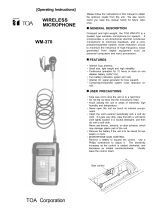Page is loading ...

OPERATING INSTRUCTIONS
WIRELESS TUNER
WT-780
WT-781
Please follow the instructions in this manual to obtain the optimum results from this unit.
We also recommend that you keep this manual handy for future reference.
TOA Corporation

GENERAL DESCRIPTION
The TOA WT-780 (WT-781) is a VHF high band tuner employing a compressor/expander system
noise reduction circuit to minimize the influence of high-frequency noise generated from digital
equipment such as personal computers and word processors. It also features a dual (noise and tone)
squelch system that allows the receiver to receive radio signals only from the microphone.
HANDLING PRECAUTIONS
Check for proper operating voltage of your tuner before use.
Supplied AC/DC adaptor must be used.
Avoid installing the unit above heat generating equipment such as a power amplifier.
To avoid severe electrical shocks and possible catastrophic damage, never open the unit nor touch
its internal components.
To clean the unit's exterior, wipe with a soft dry cloth. Never use benzine, thinner, or other solvents,
which may damage the painted parts of the unit.
FEATURES
A tone squelch prevents disturbing radio signals from producing noise when the wireless
microphone is not in use.
Wide dynamic range and less susceptibility to high frequency noise in space thanks to a
compressor/expander circuit.
Space-saving design and reliable operation.
— 2 —

NOMENCLATURE
[Top View]
Antenna
Peak Indicator
Lights when excessive input into wireless microphone
is input.
Reception Indicator
Lights when the unit receives a radio signal from the microphone.
Power Indicator
Lights when the power is supplied.
[Front View]
Volume Control
Adjusts the output volume.
Audio Output Connector
—10 dBV/Output Impedance : 10 k
unbalanced
[Side View]
DC IN
(12V
DC)
Input terminal for external power supply.
Connect the supplied AC/DC adaptor to this
connector.
— 3 —

OPERATIONS
(1) Connect the AC/DC adaptor
to the DC input terminal and
wall outlet.
(2) Set up the antenna vertically and stretch to its full length.
(3) Set the microphone power switch to ON.
The reception indicator lights.
(4) Adjust the volume control.
*Note on peak indicator
When the peak indicator lights frequently, your voice can be distorted at a microphone circuit. In such
cases, move your mouth away from the microphone so that the peak indicator lights at a maximum
level.
If the microphone is equipped with a sensitivity control, adjust the control so that the level indicator
lights when spoken loud.
CONNECTIONS
When using with the 900 series amplifiers, connect the output of WT-780 (WT-781) with the following
modules of 900 series.
900 series module
900 series amplifiers, etc.
AC/DC
adaptor
— 4 —

INSTALLATION PRECAUTIONS
Install the unit at the location accessible to the wall outlet easily.
Install the tuner away from high frequency noise generating equipment such as fluorescent lamps
and personal computers, whenever possible.
Avoid installing a receiving antenna in close proximity to the steel frames of the building or lockers.
The clearance between the antenna and the wall needs to be at least 30 cm (1 foot).
ADDITIONAL EXPLANATIONS
1. Squelch Circuit
In a receiver employing only a noise or carrier squelch, the squelch circuit is actuated and provides the
output whenever the receiver receives the same RF carrier as a receiving frequency. This causes
even a disturbing radio signal to be received provided its frequency is the same as the receiving
frequency. As a result, it can happen that sound is suddenly heard from the speaker due to disturbing
radio signal even when the wireless microphone's power switch is left OFF.
The squelch circuit of TOA's wireless systems consists of both the tone and noise squelches, and is
not actuated if only same RF carrier as the receiving frequency is received. It is so designed as to be
actuated and output a signal only when the received RF carrier contains a very exact pre-determined
tone frequency component. Therefore, disturbing radio signals are rejected and the speaker can be
kept completely quiet when the wireless microphone's power switch is set to OFF, ensuring reliable
use in every application.
2. Frequency Indicators
Component frequency ratings are expressed in combinations of alphabetic and numeric
characters, with letters substituted for all numbers to the left of the 1 MHz digit.
For example :
C = 160 MHz
D= 170 MHz
E = 180 MHz
F = 190 MHz
G = 200 MHz
H = 210 MHz
All numbers to the right of the 10 MHz digit are still expressed as numerals.
Therefore : D5432 = 175.432 MHz
G7654 = 207.654 MHz
— 5 —

SPECIFICATIONS
WT-780 (for USA,UK,AUSTRALIA)
WT-781 (for CANADA)
Power Requirements
Power Consumption
DC Input
Receiving Frequency
Receiving Sensitivity
Squelch Sensitivity
Frequency Response
Residual Noise
Antenna
Audio Output
Operating Temperature
Dimensions
Weight
Finish
120V AC, 60 Hz / 230-240V AC, 50 Hz / 240V AC, 50 Hz
Supplied AC/DC adaptor must be used.
3 W
12V DC, 110 mA
max.
169.445 MHz~171.905 MHz (FCC Part 90/USA)
174.250 MHz~215.250 MHz (FCC Part 74/USA, D.O.C/CANADA)
173.8 MHz~175.0 MHz (MPT1345/UK)
202.1 MHz~203.7 MHz (DOC 60 AUSTRALIA)
Under 20 dB µ V(S/N : 75 dB/Deviation : 15 kHz)
(S/N : 80 dB/Deviation : 40 kHz)
Approx. 14 dB µ V
100Hz~12kHz ±2dB
Less than 30 µ V(8 µ V : A-weight)
Telescopic antenna
—10dBV, 10k , unbalanced
—10°C~50°C (14°F~122°F)
140 X 31 X 108.4mm (5.51" X 1.22" X 4.27")
Approx. 260g. (0.572 Ib.)
Dark gray
Overall System Performance (WT-780/WT-781 ,WM-270/WM-271)
Transmission Distance 30~60m (100~200 feet)
Dynamic Range (SNR) Better than 90 dB (102 dB : A-weight)(60 dB µ V, 15 kHz Deviation)
Better than 95 dB (102 dB : A-weight)(60 dB µ V, 40 kHz Deviation)
Distortion Under 1%
*Specifications are subject to change without notice.
Accessories
AC/DC adaptor
AD-780 120V AC 60 Hz (USA,CANADA)
AD-781 230-240V AC 50 Hz (UK)
AD-782 240V AC 50 Hz (AUSTRALIA)
Operating instructions
TOA Corporation
KOBE, JAPAN
133-07-057-4A
1
1
/
